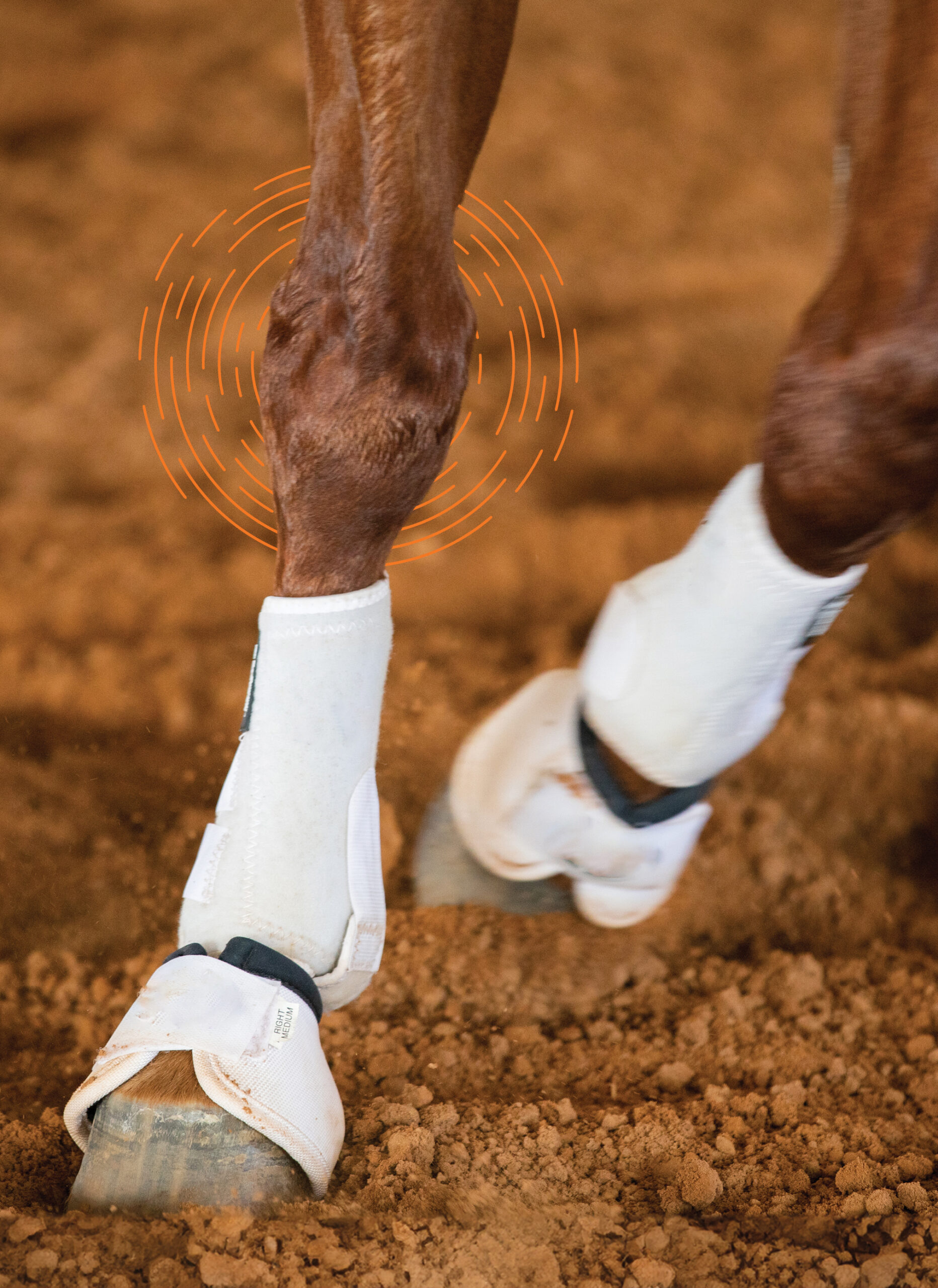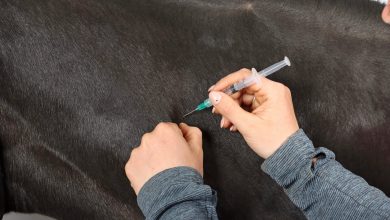Don’t Call It Maintenance! – Horse and Rider

Find out why it’s time to change the way we talk about equine joint injections.
There’s a sign-up sheet on the barn wall. Dr. X will be there next Tuesday for routine hock injections before the big show next month. Everyone else has already put their horses on the list. They’re convinced it’s an important maintenance procedure, but you’re not so sure. Your horse seems fine, and he won all his classes at the last competition. Does he really need to have his hocks injected?
Good question! Decades ago, the ‘maintenance mindset’ started going strong. It wasn’t uncommon to see horses lined up in the crossties in the weeks before competition season started waiting for their routine injections. Hocks, fetlocks, stifles … you name it. If it was a joint, it was just made to be injected. And corticosteroids, often in combination with hyaluronic acid, was the medication of choice.

These days, we know better. Veterinarians who routinely work on performance horses may still do a lot of joint injections as part of their practice. But rarely do they support routinely injecting joints just because.
Instead, joint injections are reserved as treatment for a soundness issue that’s been diagnosed. And each injection is carefully considered, including where to inject and what medication to use.
In this article, I’m going to review the basics about joint injections. I’ll tell you what they are, how they work, and why they can be an important treatment option for your horse. Then, I’ll help you get off the maintenance train, and reframe the way you think about injecting your horse’s joints.
Joint Injections 101
When your veterinarian performs a joint injection, they inject a medication directly into one of your horse’s joints. Historically, this involved a corticosteroid that helped to reduce inflammation and provide pain relief. This was often in combination with hyaluronic acid to help with lubrication, and an antibiotic to prevent infection.
While steroids are a potent anti-inflammatory and can still be beneficial in many situations, advancements over the past several decades mean we have a lot of different options for injection than we did back then. Including medications that fall under the category of regenerative therapies. These have the goal of stimulating healing rather than simply controlling signs of pain and inflammation.
Here’s a rundown of some of the most common medications your vet has to choose from when they inject your horse’s joints.

Corticosteroids
Corticosteroids are potent anti-inflammatories that can control pain, and limit damage caused by inflammatory mediators that are released into the joint when it’s injured. There are several different types of corticosteroids that may be injected. Some have the potential to damage cartilage or weaken bone (especially if used repeatedly); others have been shown to improve joint health when injected into a diseased joint. Corticosteroids are the most inexpensive and easily accessible of the medications used to inject joints.
Hyaluronic Acid (HA)
HA is injected to help provide lubrication and nutrients to the joints and can improve joint health. It’s most commonly injected in combination with corticosteroids.
Platelet Rich Plasma (PRP)
PRP is a fraction of your horse’s own blood that’s harvested and processed to be high in a type of cell called a platelet. Studies in humans demonstrate that it can help control pain and stiffness in arthritic joints, although actual impact on long-term joint health is unclear. Vets commonly use it in equine joints to reduce lameness and improve overall joint health.
Autologous Conditioned Serum (ACS)
Similar to PRP, your horse’s own blood is harvested and processed to produce a protein called Interleukin Receptor Antagonist Protein (IRAP) that blocks the activity of interleukin. This is a damaging substance released during inflammation. Your vet might choose to use ACS if your horse has not responded well to initial treatments, although it may be more effective if used early in the disease process. This treatment can be expensive and requires more complicated processing than some other options.
Polyacrylamide Gel
Polyacrylamide gels are classified as medical devices that are injected into a joint to form a type of scaffolding. With the goal of improving elasticity and viscosity or “stickiness” of the synovial fluid to help lubricate the joint. This treatment is reported to offer long-term benefits when effective. Veterinarians who use these products report that they do not work well when injected into an already inflamed joint, meaning treatment to reduce inflammation prior to injection may improve effectiveness.
Alpha-2-Macroglobulin (A2M)
This relatively new treatment is a protein that is produced by your horse’s liver. When injected directly into the joint it binds enzymes released during inflammation that can degrade cartilage. It shows promise for slowing or even stopping the development of arthritis when used early in the course of disease.
What Can Go Wrong?
It’s important to recognize that joint injections are an invasive procedure that can lead to complication—no matter what substance your vet chooses to inject. That’s one of the reasons why many veterinarians discourage routinely injecting an otherwise healthy joint. Risks include a severe inflammatory reaction (referred to as a flare), or an infection. While a flare will generally resolve on its own, an infection can be much more serious.
When a needle enters the joint, there’s always the risk of introducing foreign substances that can cause the joint to become infected. And this can even be a life-threatening complication in severe situations. The good news is that the risk of a joint injection leading to infection is much lower than many people realize—less than 0.1%.
While veterinarians historically addressed this concern by including antibiotics in the injection, recent data tells us not only that this practice doesn’t change the infection risk, but it also actually increases potential for death and destruction of cartilage cells. Because of this, veterinarians now discourage including antibiotics with joint injections. Careful preparation and good technique are most important for reducing risks.
Biggest Risk
Perhaps the biggest risk from routine joint injection is the likelihood that your horse may have a musculoskeletal injury that’s not only being missed but may be masked by an injection. This can create an even bigger risk that a more serious problem could develop.
Routine hock injections are the perfect example of where this can be a factor. Because the suspensory ligament originates just below the hock, it’s entirely possible that pain related to chronic low-grade suspensory ligament issues will improve (short term) with hock injections. That means the suspensory ligament problems are likely to go unrecognized. And training is likely to continue when rest is needed, and then the suspensory damage will get worse.
A similar situation can occur with coffin joint injections that can mask soft-tissue injuries within the foot.

What to Say Instead!
Now let’s look at the five most common statements horse owners make about joint injections, what the misconceptions are, and how we can reframe the way we talk about equine joint injections.
If you feel like saying:
“It’s time to inject my horse’s joints so I can protect them. And now he’ll stay sound for as long as possible!”
The misconception: There’s really no evidence that injecting a healthy joint provides any kind of benefit at all. In fact, depending on the choice of medication, and the potential for a complication it may even cause harm.
You might say this instead: “It’s time to schedule an evaluation with my veterinarian so we can identify potential problems. And take care of things before they progress to something more serious.”
If you feel like saying: “I’ll never let anyone inject my horse’s joints. There’s too much risk, and too much potential for damage.”
The misconception: Careful preparation and good technique can minimize the risks related to joint injections, as long as they are used appropriately. And if your horse has joint inflammation, treating it early can minimize the damage to tissues that can be caused by substances released during the inflammatory process. Just because you don’t want to sign your horse up for routine joint injections, doesn’t mean you should refuse them altogether. Injecting joints is an important part of treatment for some musculoskeletal injuries that are likely to plague a performance horse.
You might say this instead: “If my horse develops a joint-related problem that my vet believes would benefit from an injection, I will follow their advice.”
If you feel like saying:
“My horse was injected six months ago so I need to make sure I get another injection scheduled soon.”
The misconception: Jumping on a maintenance train that involves injecting your horse’s healthy joints at regular intervals, damage can be compounded over time. Especially if you are using a potent, long-acting corticosteroid with an antibiotic in the mix. Instead of protecting your horse’s joints, you’re likely to be causing even more damage to the cartilage and weakening the underlying bone. Not only that, if your horse has an underlying soft tissue injury that’s being masked with joint injections, it will continue
to get worse.
You might say this instead: “My horse responded really well to having his joint injected after my vet worked up his lameness. I should probably have him rechecked, just to make sure he’s still doing well.”
If you feel like saying:
“My horse’s joint injections used to last eight or nine months, but now I have to have him injected more frequently to keep him sound. That’s OK, I knew that once I started with injections, they would need to be more frequent over time.”
The misconception: Injecting a joint doesn’t mean you will need to inject it again and again. Nor does it mean that the interval between those injections will get closer together with time.
The ideal scenario following a joint injection targeting a specific problem is that your horse will improve and may never require another injection. If your horse initially responded well to an injection but starts having problems again, it’s important to consider whether there might be a problem that has yet to be diagnosed. And if your horse is just having his joints injected to treat arthritis there may be additional treatments that will provide relief so you can avoid more and more frequent injections.
You might say this instead: “My horse just isn’t staying as sound as I would like. I need to schedule an appointment with my veterinarian to see what the next steps might be.”
If you feel like saying:
“I just read about this new product that can be injected into my horse’s joints. I’m going to ask my vet to use it the next time they come out to the barn.”
The misconception: Just because there is a new latest, greatest medication that you see advertised online doesn’t mean it’s best for your horse. In fact, there are some situations where a steroid is likely to be the best, most effective option! It’s also important to recognize that some treatments may be most effective at different times. For example, polyacrylamide gels don’t seem to be as effective when injected into an inflamed joint. Your vet may opt to treat first with ACS, or even a steroid, before injecting a gel. It’s always best to let your vet advise you about what they think is best.
You might say this instead: “I’m going to ask my vet about this new medication I’ve been reading about. I’ll find out if it would be an option for my horse.”
Should you put your horse’s name on that sign-up sheet? Probably not. Joint injections as maintenance simply isn’t a good idea, and signing your horse up might do more harm than good. Instead of thinking about injecting joints as part of routine maintenance for your performance horse, consider scheduling regular soundness checks with your veterinarian instead. That way, you can determine whether there are subtle issues that you need to pay attention to. Even when your horse seems to be doing well!
[Read: Tips for Taking Your Horse’s Temp]


